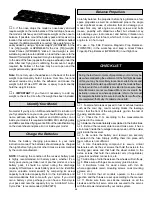
To initiate a landing approach, lower the throttle while on the
downwind leg. Allow the nose of the model to pitch downward to
gradually bleed off altitude. Continue to lose altitude, but
maintain airspeed by keeping the nose down as you turn onto
the crosswind leg. Make the final turn toward the runway (into
the wind) keeping the nose down to maintain airspeed and
control. Add power as necessary to maintain airspeed and make
it back to the runway. Level the attitude when the model reaches
the runway. If you are going to overshoot the runway, smoothly
advance the throttle (always ready on the right rudder to
counteract torque) and climb out to make another attempt.
When ready to make a landing flare and the model is a foot or
so off the deck, smoothly increase up elevator until gently
touching down. Once the model is on the runway and has lost
flying speed, apply up elevator to hold the tail on the ground.
One final note about flying the Ryan (or any model). Have a
goal or flight plan in mind for every flight. This can be learning
a new maneuver(s), improving a maneuver(s) you already
know, or learning how the model behaves in certain
conditions (such as on high or low rates). This is not
necessarily to improve flight skills (
though it is never a bad
idea!), but more importantly so you do not surprise yourself by
impulsively attempting a maneuver and suddenly finding that
you've run out of time, altitude or airspeed. Every maneuver
should be deliberate, not impulsive. For example, if planning a
loop, check your altitude, mind the wind direction (anticipating
rudder corrections that will be required to maintain heading),
remember to throttle back at the top and make certain you are
on the desired rates (high/low rates). A flight plan greatly
reduces the chances of crashing just because of poor
planning and impulsive moves. Remember to think.
Have a ball! But always stay in control
and fly in a safe manner.
GOOD LUCK AND GREAT FLYING!
Landing
EM60120
PATTERN
Windscreen Pattern

































